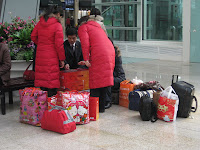
On Thursday, after hosting the first session of the “Professional English Corner” I was invited to have lunch with my Teaching Assistant, Gao Bo, several of her graduate classmates in Preventive Medicine and their Faculty Advisor.
We walked from the campus to Jin Guan Tang, a
Sichuan restaurant just a few blocks away.
The restaurant, like many others, is situated on the second floor, saving space on the street level for small shops.
As is typical in this area of
China, at least, the dishes arrive one at a time, but seem to never cease to arrive.
For today’s lunch, Dr. Li chose the following dishes:
Pickled lotus root (delicious)
Whipped sweet potato deep fried and stuffed with sweet bean paste
White radish and smoked pork
Chopped pieces of duck with red peppers and scallions
Steamed fish topped with sliced onions and scallions
Diced eggplant in a delicious sauce
Long stemmed mushrooms with green peppers
Toasted deep fried sesame rolls, and
Kung Pao chicken topped with large chunks of hot red pepper!
Just a few dishes, I would say! I am amazed at how much food is served for these lunches and dinners. Some guide books say it is a type of compensation for the scarcity of food available to anyone during the Cultural Revolution. Others say it is the Chinese sense of graciousness. By any standard, the meal was more than ample for the six of us.
The occasion of the luncheon was the one-month birthday of Maye’s (Zhang Min) new little baby boy. In keeping with the local custom, Maye had invited her graduate school classmates and her faculty advisor and me out to lunch to celebrate the day. I assume from the conversation that she would also host another meal for her family and friends. We chatted a bit about the baby; I asked to see his photograph. He was just precious – seemed to be smiling, already, at one month. Maye told me his Chinese name – but its multiple vowel sounds quickly escaped my memory. She also told me that he didn’t have an English name yet, but wondered if I would chose one for him. I was in a Peter mood; it is a name I’ve always liked; and, so I think little Zhang’s English name is now Peter!
Sichuan Food is famous the world over. The meal that we ate on Thursday was testimony to the freshness of the foods and the range of flavors. The pickled lotus root was delicious; -- I’m a pickle fan almost anywhere. But, the steamed fish – which is the next to last dish usually served – is absolutely delicious. There are two things that make is so good. First, is that the fish must be steamed above the water, in a sauce flavored with soy and other spices. Second…and key…is choosing an absolutely fresh fish to be steamed. One friend described how you can run your finger across the fish’s scales and know exactly how fresh the fish is. Another, jokingly –maybe—described grabbing a live fish from a tank to be steamed as he entered a restaurant.
Sichuan food is spicy … "hot" also comes in many flavors. I notice that the food is cooked with large chunks of hot red and green peppers, but typically these chunks are not eaten. Rather, the peppers are used to flavor the food. There is one peculiar little spice that I have never seen before; it is slightly larger than a pepper corn but has a prickly skin; it goes by the name “hua jiao.” It gives the food an unusual hot, slightly prickly taste. A touch of it is delicious. However, I did make the mistake of taking one of these little guys and chewing on it. What a surprise. Now when I tell my Chinese friends that I call this little seed “Chinese Novocaine” I always get a lively chuckle.
Still, the freshness and the flavors of Sichuan Cuisine guarantee every meal will be a delectable adventure in taste!






